...
From the Subpart Overview page, select "ADD a Waste Stream" located under the “Waste Stream Summary" section.
| Wiki Markup |
|---|
{composition-setup}{| Composition Setup |
|---|
} |
|---|
|
| Wiki Markup |
|---|
{
:=}Click image this link to expand Image Modified
Image Modified
| Cloak |
|---|
| Wiki Markup |
|---|
{cloak:id=PNG1|| cloak.toggle.zone | true |
|---|
| id | PNG1 |
|---|
| | =none|cloak.toggle.zone=true}
 Image Removed
Image Removed
Subpart TT requires a facility to uniquely identify and provide the information described below for each waste stream placed into the landfill.
| Wiki Markup |
|---|
{composition-setup}{composition-setup} |
| Wiki Markup |
|---|
{
:=}Click image this link to expand 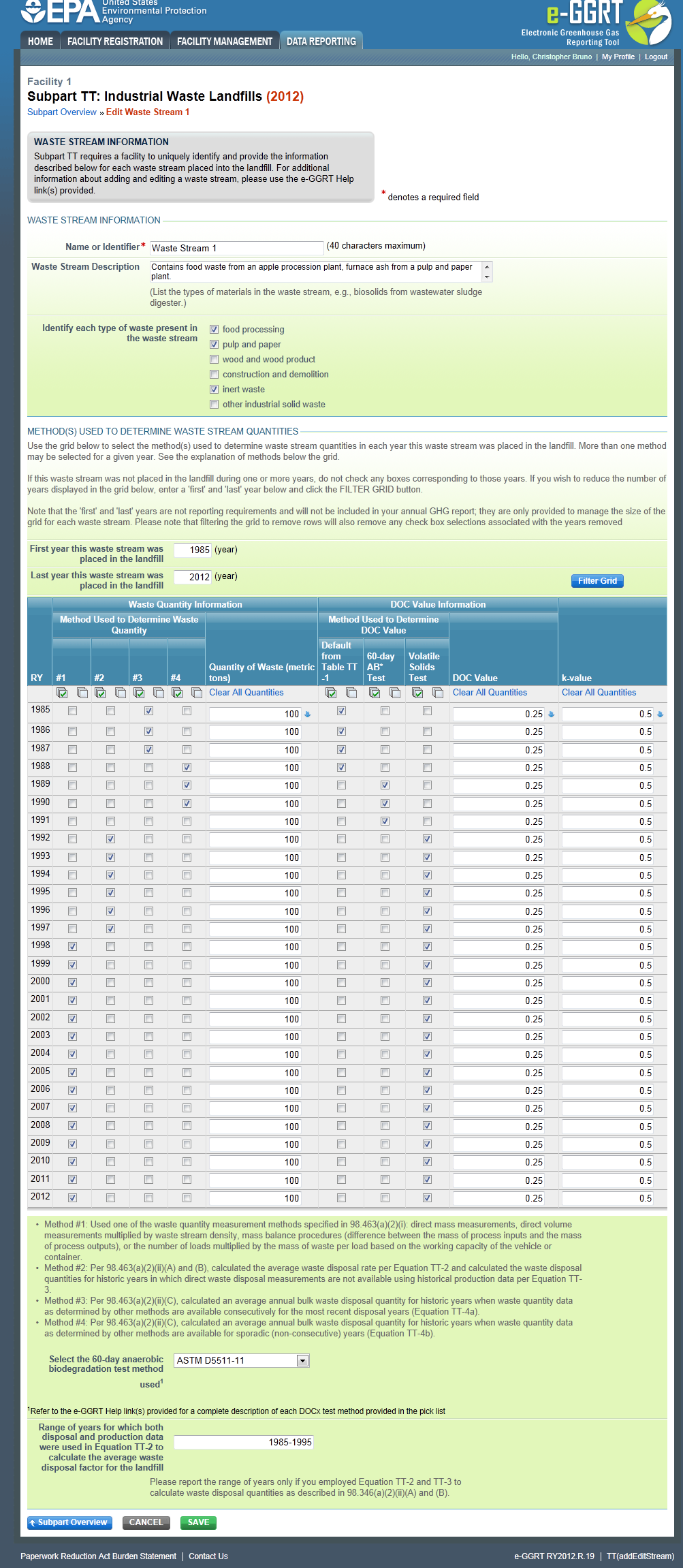 Image Removed
Image Removed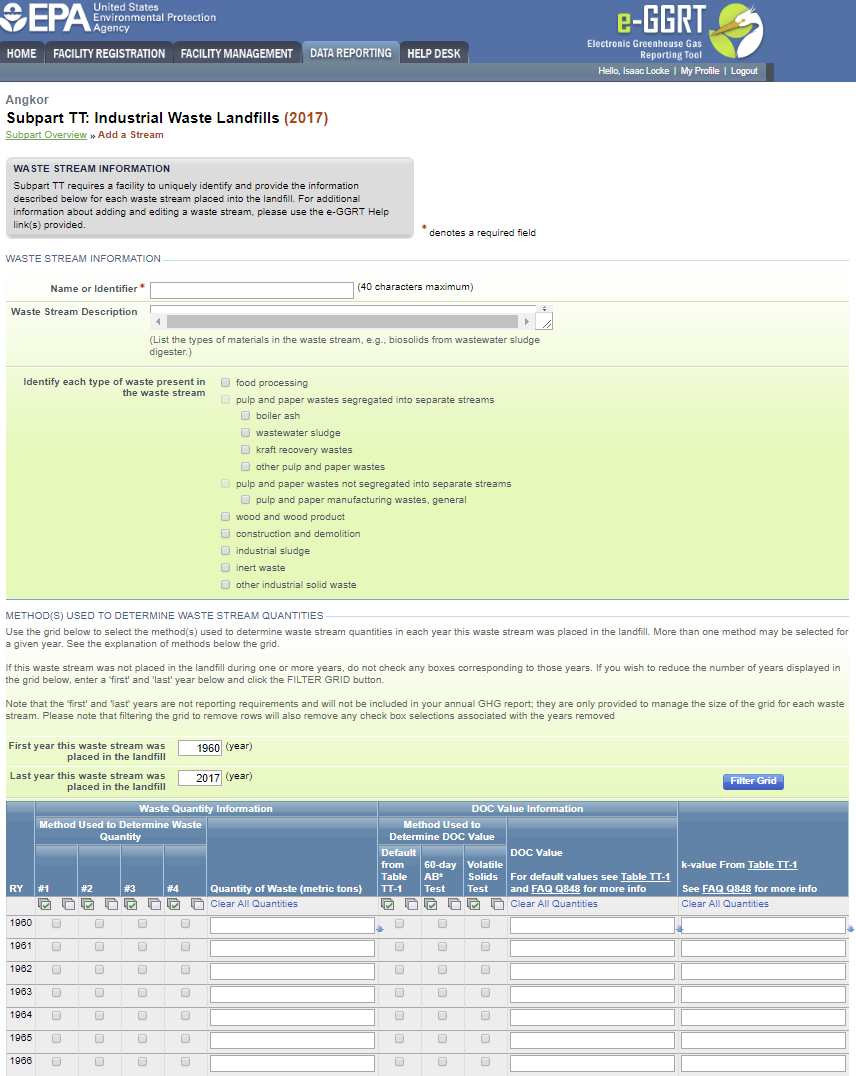 Image Added
Image Added
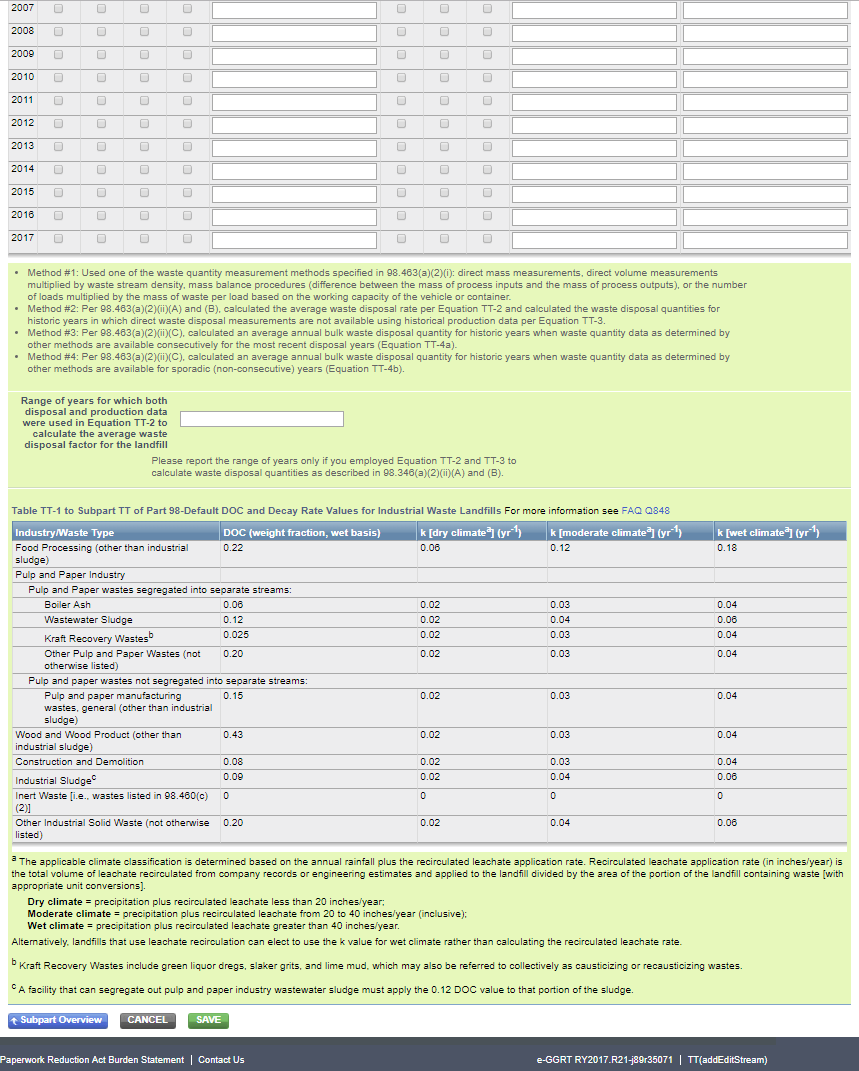 Image Added
Image Added
| Cloak |
|---|
| Wiki Markup |
|---|
{cloak:id=PNG2| | type=none|| zone | true |
|---|
| id | PNG2 |
|---|
| cloak.toggle. |
|---|
| zone=true}
 Image Removed
Image Removed
Waste Stream Information
Subpart TT requires the following information.
...
- A unique name or identifier
- A description of the waste stream. The description should be detailed and include a list of the types of materials that are contained in that waste stream , (e.g. biosolids from a wastewater sludge digester, food waste from a date processing plant, or boiler or furnace ash from a pulp and paper facility).
- An indication of each type of waste (as listed in Table TT-1) present in the waste stream. Check the box next to each type of waste present in the waste stream:
- food processing
- pulp and paper wastes segregated into separate streams
- boiler ash
- wastewater sludge
- kraft recovery wastes
- other pulp and paper wastes
- pulp and paper wastes not segregated into separate streams
- pulp and paper manufacturing wastes, general
- wood and wood product
- construction and demolition
- industrial sludge
- inert waste (wastes listed in 98.460(c)(2))
- other industrial solid waste (not otherwise listed)
| Note |
|---|
If the landfill is located at the facility generating the waste, “waste stream” refers to the waste material generated by a specific manufacturing process. In this case, it is expected that each waste stream would have only one “waste type” and only one item from this list would be checked. If the landfill is a commercial landfill that receives wastes from a number of clients, the “waste stream” refers to wastes generated and/or received from a specific client. As the wastes received from a single client may include wastes from a number of different processes, it may be appropriate to list multiple waste types for a given client’s waste stream and so multiple boxes on this list may be checked. |
...
For each year that waste is placed in the landfill, e-GGRT will also require you to provide the quantity of waste disposed in the landfill in metric tons. Enter the quantity in the box to the right of the check boxes. If quantities in each year are the same, you may make all quantities the same for each year by clicking the blue downward-facing arrow to the right of the box. If waste was not placed in the landfill in a given year, either enter a 0 in the Quantity of Waste column, or leave this column blank and do not select a method. If you make a mistake, you may also click "Clear All Quantities" at the top of that column to clear waste disposal quantities for all years.unmigrated-inline-wiki-markup
{
:id=PNG4}Click image this link to expand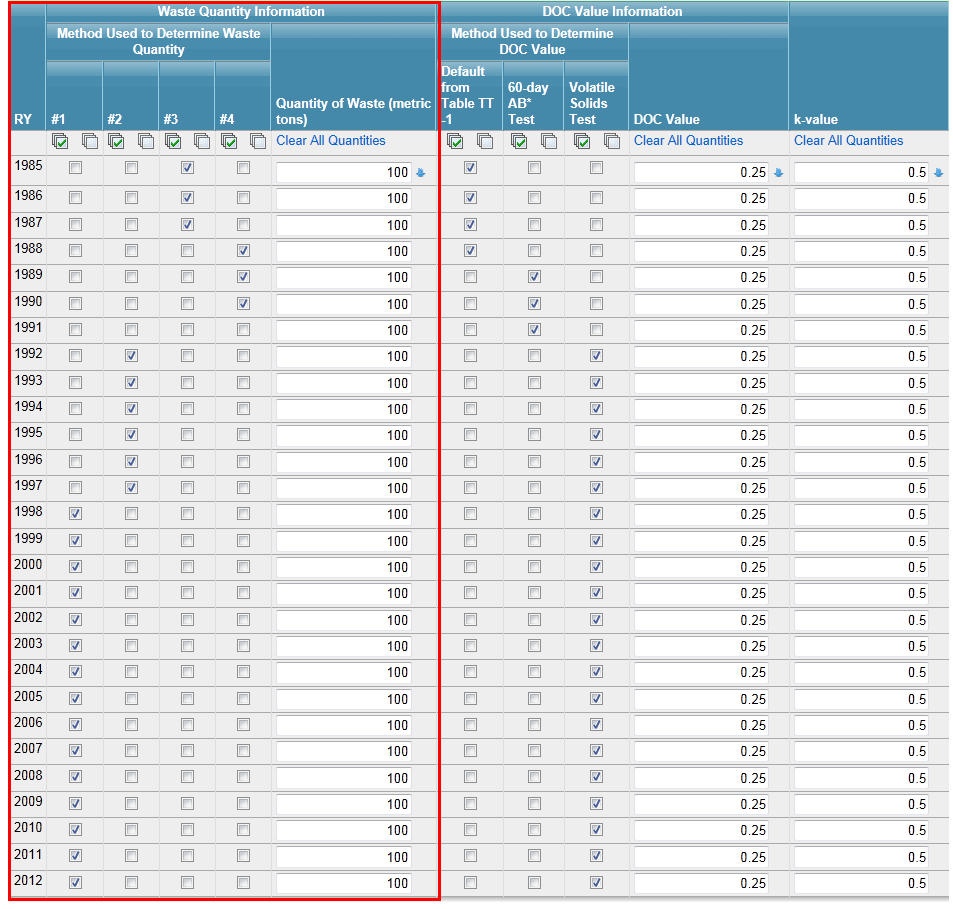
| Cloak |
|---|
| Wiki Markup |
|---|
{cloak:id=PNG4| | type=none|| zone | true |
|---|
| id | PNG3 |
|---|
| cloak.toggle. |
|---|
| zone=true}
 Image Removed
Image Removed
Degradable Organic Carbon (DOCx)
...
For each year that waste is placed in the landfill, you will also be required to report the DOCx value as a mass fraction. To do this, enter the value into the box to the right of the check boxes. If quantities in each year are the same, you may make all DOCx values the same for each year by clicking the blue downward-facing arrow to the right of the box. If waste was not placed in the landfill in a given year, do not enter a value for DOCx for this year. If you make a mistake, you may also click "Clear All Quantities" at the top of that column to clear DOCx values for all years.
See FAQ 848 for more information on use of the values for DOCx in Table TT-1.
| Wiki Markup |
|---|
{
:id=PNG3}Click image this link to expand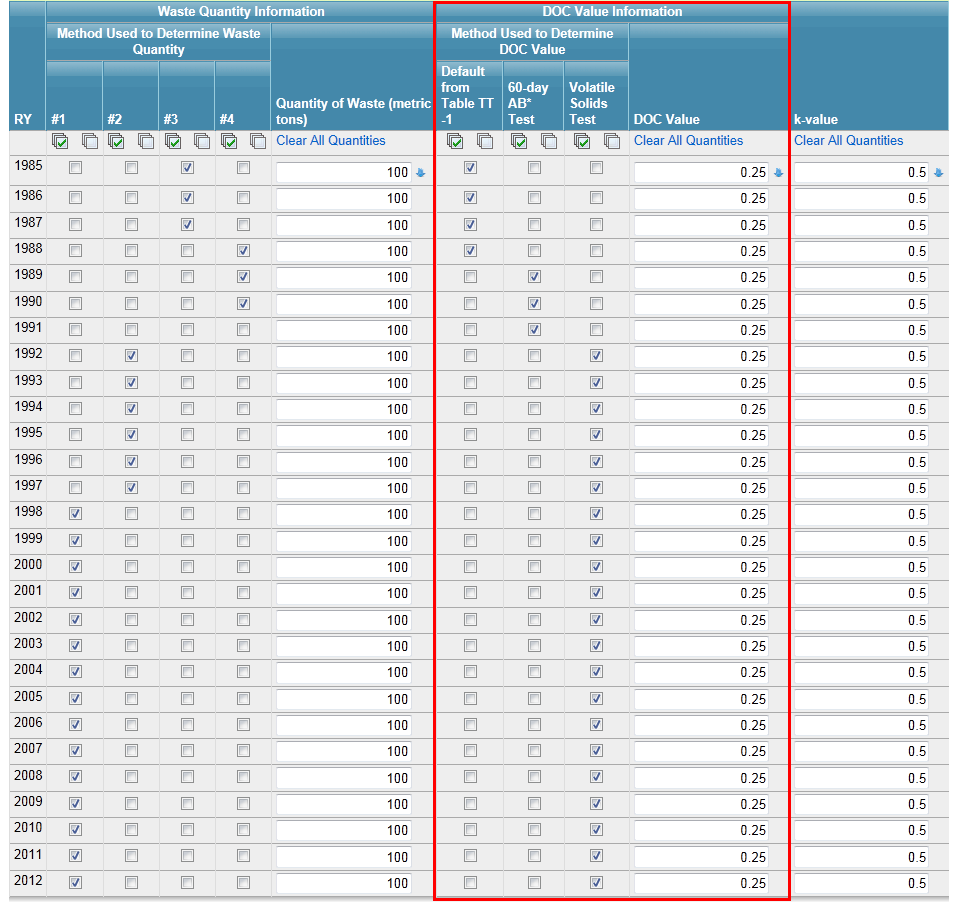
| Cloak |
|---|
| Wiki Markup |
|---|
{cloak:id=PNG3| | type=none|| zone | true |
|---|
| id | PNG4 |
|---|
| cloak.toggle. |
|---|
| zone=true}
 Image Removed
Image Removed
If DOCx was determined based on a 60-day anaerobic biodegradation test, select the test method used in the dropdown menu underneath the tablegrid. If a method other than the ones listed was used, check “Other” and specify the method used in the text box that appears.
...
.
...
The Decay Rate (k) Value
You will be required to report the applicable decay rate (k) value (percentage expressed as a decimal fraction) from table TT-1 for each waste stream used in Equation TT-1.
Enter the k-value into the boxes in the last column of the table. If the value in each year is the same, you may make all values the same for each year by clicking the blue downward-facing arrow to the right of the box. If waste was not placed in the landfill in a given year, do not enter a value for k for this year. If you make a mistake, you may also click "Clear All Quantities" at the top of that column to clear k-values for all years.unmigrated-inline-wiki-markup
{
:id=PNG6}Click image this link to expand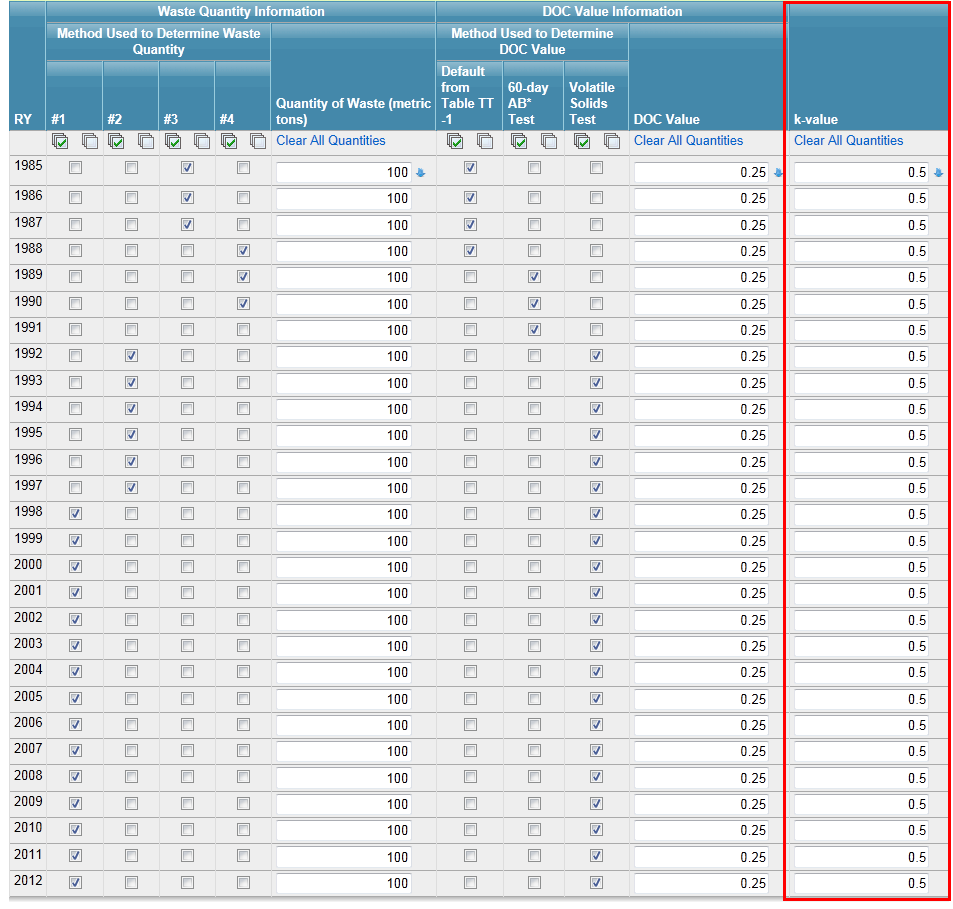
| Cloak |
|---|
| Wiki Markup |
|---|
{cloak:id=PNG6|cloak.toggle.type=none|| cloak.toggle.zone | true |
|---|
| id | PNG5 |
|---|
| | zone=true}
 Image Removed
Image Removed
The last question in this section of Subpart TT should only be answered if Equations TT-2 and TT-3 were used to calculate waste disposal quantities in years prior to the reporting year. If these equations were used, provide the range of years for which both disposal and production data were used in Equation TT-2 to calculate the average waste disposal factor for the landfill
Once all appropriate boxes have been checked and all data entered, click SAVE at the bottom of the page and review the data entered. Then click Subpart Overview to return to the Subpart Overview screen.
| Wiki Markup |
|---|
{composition-setup}{composition-setup} |
unmigrated-inline-wiki-markup
{
:id=PNG5}Click image this link to expand  Image Removed
Image Removed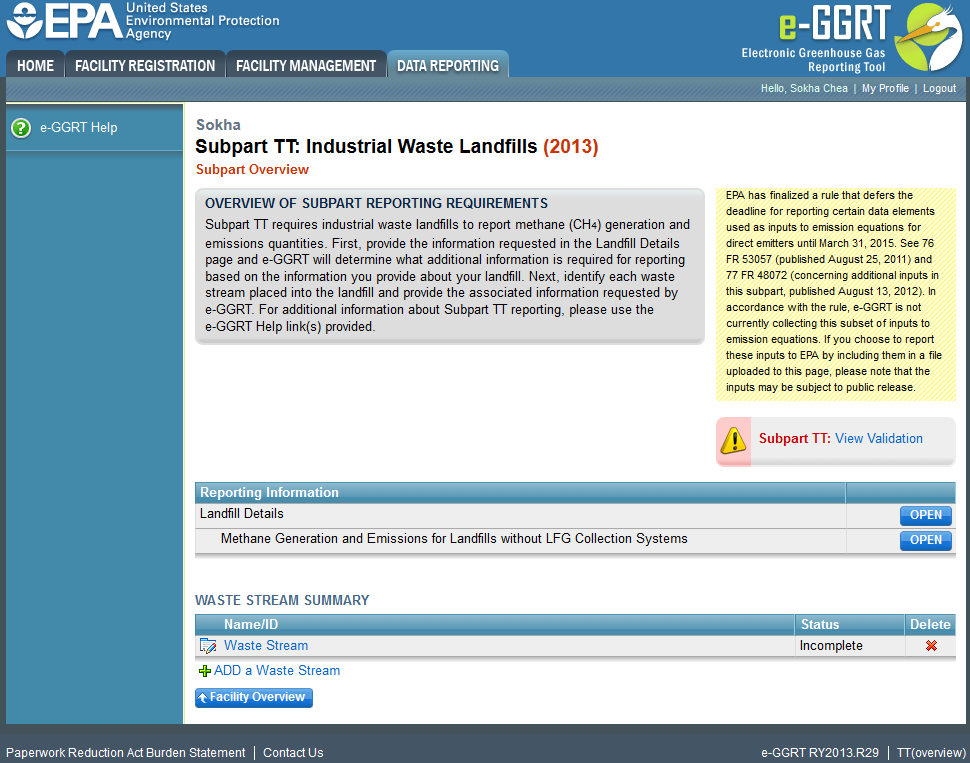 Image Added
Image Added
| Cloak |
|---|
| Wiki Markup |
|---|
{cloak:id=PNG5| | type=none|| zone | true |
|---|
| id | PNG6 |
|---|
| cloak.toggle. |
|---|
| zone=true}
 Image Removed
Image Removed
On the Subpart Overview page, check that the status for each waste stream entered is “Complete.” If any waste stream is not “Complete” you must go back into that waste stream and complete any missing information. If more waste streams are disposed at the landfill, add information on those waste streams by clicking “ADD a Waste Stream” and following the previous steps until information on all waste streams are entered.










